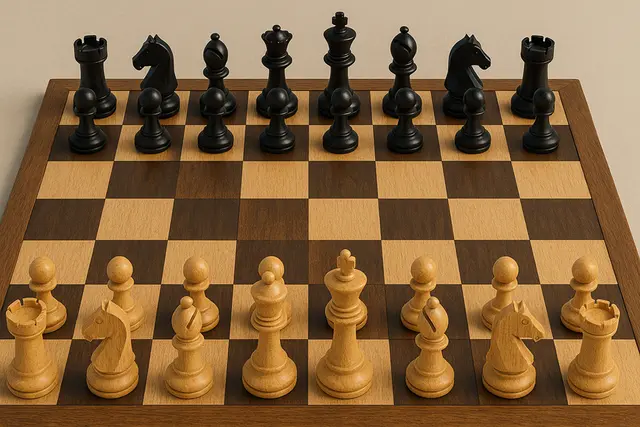Basic Rules of Play
Official FIDE rules for how to play chess - perfect for beginners and young players
The Chessboard
Chess is played on a square board divided into 64 squares (8x8) of alternating colors. Each player starts with 16 pieces: one king, one queen, two rooks, two bishops, two knights, and eight pawns.

Remember!
The board must be positioned so that each player has a white (or light) square in the right-hand corner. A simple way to remember is: "White on right!"
How Pieces Move
Each type of chess piece moves in a distinct way. Here are the basic movement rules for each piece:
King
Moves one square in any direction. The most important but not the strongest piece.
Queen
Moves any number of squares in a straight line in any direction. The most powerful piece.
Rook
Moves any number of squares in a straight line horizontally or vertically.
Bishop
Moves any number of squares diagonally. Each bishop stays on the same color squares.
Knight
Moves in an "L" shape: two squares in one direction then one square perpendicular. Can jump over other pieces.
Pawn
Moves forward one square, but captures diagonally. On its first move, it can move forward two squares.
Example
A knight on e4 can move to: c3, c5, d2, d6, f2, f6, g3, or g5. The knight is the only piece that can "jump" over other pieces.
Special Rules
Chess has several special rules that make the game more interesting:
| Rule | Description |
|---|---|
| Castling | The king moves two squares toward a rook, and the rook moves to the square the king crossed. Conditions: Neither piece has moved, no pieces between them, king not in check. |
| En Passant | If a pawn moves two squares from its starting position and lands beside an opponent's pawn, the opponent can capture it as if it had moved only one square. |
| Pawn Promotion | When a pawn reaches the opposite side of the board, it can be promoted to any other piece (except king), usually a queen. |
| Check | When a king is under immediate attack by an opponent's piece. The player must get out of check on their next move. |
| Checkmate | When a king is in check and there is no legal move to escape. This ends the game. |
Winning the Game
A game of chess can end in several ways:
- Checkmate: The primary way to win. Your opponent's king is in check with no legal moves to escape.
- Resignation: A player may resign, conceding the game to their opponent.
- Timeout: In games with time controls, if a player runs out of time, they lose (unless the opponent doesn't have enough material to checkmate).
- Draw: The game ends in a tie. This can happen by agreement, stalemate, threefold repetition, the 50-move rule, or insufficient material to checkmate.
Stalemate Example
If it's Black's turn to move but they have no legal moves and their king is not in check, this is stalemate - the game is a draw!
Test Your Knowledge
Let's see how well you understand the basic rules of chess!